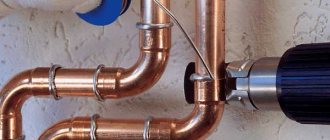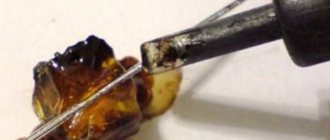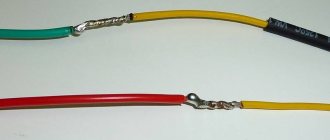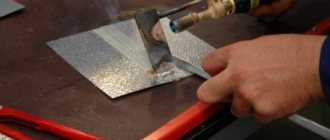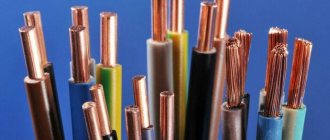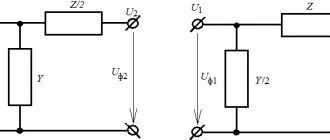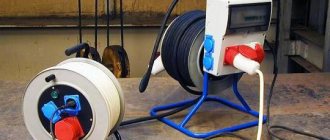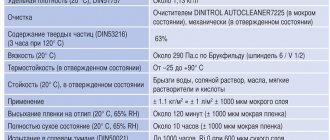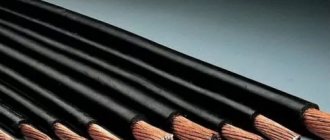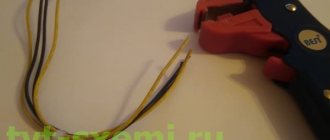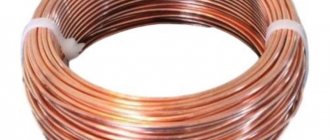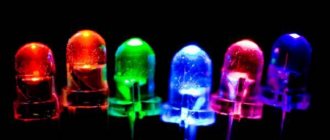What are distribution boxes for?
Box for connecting wires
The need to use distribution boxes should not raise any doubts. To make sure of this, you should read the warnings of experts:
- Neglecting the installation of the structure is a violation of the rules set out in regulatory documents.
- Compliance with fire safety. Thanks to the RK, the likelihood of short circuits and fire is significantly reduced, due to the tightness of the structure.
- Installing the device will take a lot of time, but in the future it will be much easier to upgrade, maintain, repair and extend wires. For example, if you need to install an additional socket or switch, the necessary wires can be removed from the junction box.
In general, installation of a distribution box is required. The installation technology is simple; difficulties may arise when connecting the wires.
General switching rules
The implementation of the soldering method is reminiscent of welding work, only an ordinary soldering iron is used, and not an inverter apparatus with electrodes. Before twisting, the cores must be tinned. To do this, heat up the soldering iron, immerse it in rosin and pass it over the areas stripped of insulation several times until a reddish tint appears.
To ensure quality work, you must first check the soldering iron tip. It is important that it is clean. If the surface is uneven and dirt has accumulated on it, it will be impossible to make high-quality solder. Contaminants are removed with a file, then its end is tinned again.
Twist connection
Twisting of copper and aluminum wires is not recommended. If you cannot do without this, then first you should tin the copper conductor, that is, cover it with lead-tin solder. This way you will eliminate the possibility of direct interaction between aluminum and copper.
Do not forget that aluminum is very soft and brittle and can break even under minor loads, so twist it very carefully. Do not forget to properly insulate the connection; in this case, it is best to use heat-shrinkable tubing.
We tried to tell you in detail whether it is possible to connect wires made of aluminum and copper, as well as how to do this efficiently and reliably. Choose the most suitable method for yourself, depending on where this connection will be switched and operated.
How to connect two aluminum wires to each other? It would seem like a rather banal question, but even here the first answer that comes to mind is not always correct. After all, twisting of wires is prohibited according to the PUE standards, and any wires can be connected only by crimping, soldering, welding and using screw clamps. And we’ll talk about how to do it correctly in our article.
Advantages of soldering compared to other connection methods
Tool for removing insulation from wires - stripper
There are several ways to connect wires in a junction box, however, only soldering and welding differ in the minimum transition resistance and monolithic connection. Anyone can solder wires at home. Welding requires experience and a special welding machine.
To carry out the work you will need the following set of tools:
- flux;
- a knife designed to remove insulating material;
- solder;
- side cutters;
- soldering iron;
- pliers or pliers;
- sandpaper.
You cannot begin work without first preparing all the necessary tools and consumables.
Soldering wires
Removing insulation from the wire
Tinning and soldering of cables in the junction box is carried out in several stages.
- Removing the insulating layer.
- Stripping the wires until the characteristic shine of the metal appears.
- Maintenance.
- Twisting.
- Soldering.
- Isolation.
Before you start connecting the current-carrying wires, you need to analyze what length is required. The wires are cut so that when soldering the ends are located outside the junction box. Upon completion of the work, they are laid in any desired way.
Soldering wires in the junction box is prohibited. The stock in this case is also inappropriate.
To remove the insulating layer, a special tool is used - a stripper or a sharp knife. When working with a sharp knife, the movements should resemble whittling a pencil. It is forbidden to cut the insulating layer with pliers or side cutters; you cannot make circular cuts. Transverse damage will cause a break in the near future.
For a wire intended for soldering, stripping ranges from 1.5-3 cm. The number of turns is at least 2.
Main types of solder wire connections
Before soldering, the wires are thoroughly cleaned and tinned so that oxides do not appear on the surface of the conductors, which interfere with normal conductivity and increase resistance. Already tinned conductors are twisted using pliers or pliers.
Soldering twisted copper wires in a box has a similar algorithm. The twist must be tight, but not tight, otherwise the ends of the conductive wires may simply break off.
Finally, the twisted wires are soldered with a soldering iron so that the solder is covered with an even layer on all sides. The quality of the work depends entirely on how well the ends were stripped.
Walnut clip
Another good way to connect copper and aluminum wires is to use nut clamps. It is more correct to call this device a branch compressor. It was already the electricians who nicknamed it “the nut” because of its external resemblance.
It is a dielectric polycarbonate housing, inside of which there is a metal core (or core). The core is two dies, each of which has a groove for a certain cross-section of the conductor, and an intermediate plate, all of which are connected to each other with bolts.
Such clamps are sold in any electrical goods store; they have different types, which depend on the cross-section of the wires being connected. The disadvantage of such a device is that it is not sealed, that is, there is the possibility of moisture, dust and even small debris getting in. For reliability and quality of connection, it is better to wrap the “nut” with insulating tape on top.
The process of connecting wires using this compression is as follows:
- Disassemble the compression housing; to do this, pry up and remove the retaining rings using a thin screwdriver.
- On the wires to be connected, strip the insulating layer to the length of the dies.
- Unscrew the fixing bolts and insert the exposed conductors into the die grooves.
- Tighten the bolts, position the die in the compression housing.
- Close the housing and install the retaining rings.
Read also: How to ring a power supply transformer
A practical example of using a nut clamp is shown in this video:
Selecting the power of the soldering iron
To perform high-quality work, you need to use fairly powerful soldering irons, at least 65 W. This is especially important when working with copper wires, since copper is a good conductor of heat, therefore, it removes heat from the soldering area. If the power of the device is not enough, this can lead to “cold soldering” - the solder covers the soldered area unevenly, and the strength will be low.
The device should optimally heat the area for 1 minute and no more, the surface of the solder at the end of the work should be smooth and have a uniform shine.
Reasons for incompatibility
The main reasons for the undesirable connection between these two metals lies in the aluminum wire.
There are three reasons, but they all lead to the same result - over time, the contact connection of the wires weakens, begins to overheat, the insulation melts and a short circuit occurs.
- Aluminum wire has the ability to oxidize when exposed to moisture in the air. This happens much faster when in contact with copper. The oxide layer has a resistivity value greater than that of the aluminum metal itself, which leads to excessive heating of the conductor.
- Compared to copper conductor, aluminum is softer and has lower electrical conductivity, due to which it heats up more. During operation, the conductors heat up and cool down many times, resulting in several cycles of expansion and contraction. But aluminum and copper have a large difference in the magnitude of linear expansion, so a change in temperature leads to a weakening of the contact connection, and weak contact is always the cause of strong heating.
- The third reason is that copper and aluminum are galvanically incompatible. If you twist them, then when an electric current passes through such a unit, even with minimal humidity, a chemical electrolysis reaction will occur. This, in turn, causes corrosion, as a result of which the contact connection is again broken, and as a result, heating, melting of the insulation, short circuit, and fire.
Solder type
There is a wide variety of solders, the main ones are listed in the table.
| Solder grade | Compound (%) | Tensile strength (kg/mm) | Melting temperature | Application |
| POS-30 | Lead – 70 Tin – 30 | 3,2 | 266 | For soldering and tinning of parts made of steel, copper and their alloys |
| POS-40 | Lead – 60 Tin – 40 | 3,8 | 238 | For soldering and tinning of contacts and parts in radio equipment made of galvanized steel |
| POS-90 | Lead – 10 Tin – 90 | 4,9 | 220 | For soldering and tinning of medical instruments and metal utensils |
| POS-61M | Copper – 2 Lead – 37 Tin – 61 | 4,5 | 192 | For soldering and tinning of printed conductors and copper wires |
| POS-61 (tertiary) | Lead – 39 Tin – 61 | 4,3 | 190 | For tinning and soldering of live parts made of bronze, brass and copper with sealed seams |
| POSV-33 | Bismuth – 33.3 Lead – 33.3 Tin – 33.3 | — | 130 | For soldering parts made of constantan, brass and copper with a sealed seam |
| POSV-50 (Alloy Rose) | Bismuth – 50 Lead – 25 Tin – 50 | — | 94 | For processing parts that are susceptible to overheating |
| Alloy d Arce | Bismuth – 45.3 Lead – 45.1 Tin – 6.9 | — | 79 | For the production of fuses, tinning and soldering of parts susceptible to overheating |
| Wood's alloy | Cadmium – 12.5 Bismuth – 50 Lead – 25 Tin – 12.5 | — | 68,5 | An important feature is that it is toxic. Designed for the manufacture of fuses, tinning and soldering of parts susceptible to thermal effects |
The last three grades have a low melting point and low alloy strength.
Adviсe
- When using a bolted connection , it is necessary to remember the fluidity of aluminum - the clamping bolt must be periodically tightened so that the aluminum does not leak out over time. At the same time, the mechanical pressure on the cable without tension should not exceed 150 kg/cm2. When the tip is clad with copper, the pressure should not exceed 100kg/cm2. When heating live wires, the maximum pressure is no more than 200 kg/cm2. If these values are exceeded, the aluminum cable will “leak” under voltage.
- If you have no other choice but to use simple twisting, you must remember that the contact will be more reliable when using certified PPE caps. Remember that any cable contacts covered only with electrical tape are not recommended.
- For quick and high-quality soldering of aluminum cables, it is necessary to replace rosin with high-quality mineral oil (for sewing machines) or gun oil.
- When choosing self-clamping terminals , we recommend reading the markings, which display the number and cross-sectional area of the cable for which the device is designed.
- Any mechanical connection of an aluminum wire with a copper wire is possible only when the latter is coated with tin-lead solder.
In residential buildings that were built in Soviet times, electrical wiring was carried out with aluminum wires. Professional electricians prefer to make a modern household network with copper wires. Therefore, whether we like it or not, we often have to face the problem of how to connect copper and aluminum wire. Don’t listen to those who tell you that you absolutely can’t do this. Of course, not all methods are suitable for this case, however, connecting electrical aluminum and copper wires is a completely solvable task. The main thing is to do everything correctly.
These two metals have different chemical properties, which affects the quality of their connection. But there were smart heads who figured out how to connect two conductors, while eliminating direct contact between them.
We will look at all existing options for how you can connect copper and aluminum wires, but first, let's figure out why this cannot be done with ordinary twisting and what is the reason for this incompatibility?
Protecting the soldering area from oxidation
Flux for soldering
Flux is used to protect the soldering area from oxidation by oxygen. When working with copper, the following are most often used:
- Rosin, it contains only pine rosin.
- LTI-120 includes triethanolamine (1-2%), aniline hydrochloride (3-7%), ethyl alcohol (66-73%), rosin (20-25%).
- The composition of alcohol rosin includes ethyl alcohol (60-70%) and rosin (30-40%).
The simplest, most budget-friendly and at the same time widespread version of flux is ordinary rosin. The only difficulty that may arise when working with a substance is its solid state of aggregation.
Soldering and tinning technology
A simple method of tinning
When starting to solder or tinning wires, it is important to place the wires horizontally so that the soldering iron tip touches all sides without hindrance. Some “experts” recommend placing conductive wires vertically, but this should not be done, since drops of solder may begin to spread.
Before tinning, the wires are heated with a soldering iron and, at the same time, they touch the heating area with a piece of rosin until it begins to melt. If liquid flux is used, it is applied first before heating begins. After tinning, the wires are twisted.
Soldering technology is slightly different because it requires a larger amount of solder. Flux is applied to the conductive wires and heated with a soldering iron until the molten drop is evenly distributed. If necessary, the procedure can be repeated.
Soldering with a torch and crucible
Device for soldering wires
If there is a large amount of work to be done, it is advisable to use crucibles, which are a hollow metal cylinder equipped with a handle for filling with molten solder. This device can be heated with a gas burner or used as an attachment for a powerful soldering iron.
The container holds a small amount of molten solder; while it hardens, a person has time to make several twists.
What tools and materials will be needed?
The choice of tools and materials we need will be determined by our specific goals, as well as the soldering methods used. The main tool used is either an electric soldering iron or a gas torch. Well, then there will be, in general, a standard soldering kit. We will need:
- Knife for cutting wire insulation - do not forget to sharpen it or use a stationery knife. You can also make an electrician's knife with your own hands.
- Pliers for twisting conductors.
- Solder and flux. Flux is a substance with which we remove oxidation from the surface we solder. Solder is what is used to directly solder the wires.
- File – a fine file will do.
When soldering wires with a soldering iron or gas torch, different solders and fluxes can be used. So, for copper conductors you need solder based on a mixture of tin and lead - these are solders of the POS-40, POS-50, POS-60 brands. The following grades are suitable for soldering aluminum wires: P-250A (zinc and tin), TsO-12 (zinc and tin), TsA-15 (zinc and aluminum), A (zinc, tin, copper). Rosin is used as a flux - an organic material containing a mixture of resin acids from coniferous trees. Rosin is the most common and inexpensive option. There are also methods of soldering with acid as a flux, but it is not recommended to use them because they are harmful. In addition, acid causes corrosion on the twist over time.
Precautionary measures
Caution should be exercised during work as molten solder can cause severe burns if it comes in contact with the skin. All brands of solder contain lead, the vapors of which are toxic to humans. To prevent poisoning, you need to wear a respirator when working.
When soldering wires, it is prohibited to use acid-containing active fluxes, since they require complete removal after completion of the work. Flux residues have a destructive effect on all materials; soldering acid and zinc chloride are especially aggressive for copper.
In general, the work should not cause difficulties, the main thing is to familiarize yourself with the execution technology in advance, prepare all the consumables and tools.
Safety precautions
- When connecting wires , you must be careful and strictly follow the operating instructions, which prohibit simple twisting (twisting in a spiral) of wire made of aluminum and any other metal (copper, aluminum-copper, aluminum). The reason is that when aluminum oxidizes, it releases galvanic vapor, which will sooner or later break the contact, and sparks that occur when high-power currents pass through such contacts often cause a fire.
- Aluminum welding is the most traumatic - to avoid trouble, be sure to use rubber boots and a welding helmet.
- in the room where welding is carried out to prevent fire.
- Even wooden floors are recommended to be covered with iron sheets.
Read also: Copper-plated or copper-plated correctly
